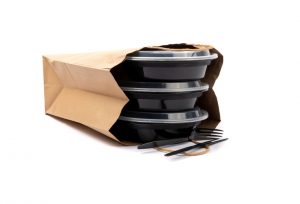Single-use plastic, once viewed as a packaging marvel, has quickly become the scourge of our planet for a generation of consumers. Product marketing and quality go out the window if shoppers disagree at a moral level with a component of the product. So, how do you get around the pitfalls of plastic packaging while maintaining the integrity of the food product itself?
The key is to make better use of sustainable food packaging; make eco-friendly packaging work for you and then leverage it for marketing purposes. Below are several examples of smart eco-friendly food packaging, as well as tips for how to make sustainable packaging that delivers.
Package in Reusable Containers
Over the last several years, we have seen an explosion of glass and hard plastic water bottles lead to the phasing out of single-use bottles. Some businesses have even built these options into their corporate strategy, offering discounts for customers who return for refills with reusable containers. However, it’s not just bottles. We are seeing the same principle applied to produce, coffee beans and more. Even pet foods and cosmetics are being reimagined with reusable packaging. When given the opportunity for reusable packaging, consumers show a propensity towards it.
Use Recyclable Materials
If single use in unavoidable, using a material that is recyclable is a great way to reduce waste and please the consumer. If you can help it, don’t make a consumer hunt for the “recyclable” label. Often, a person will assume the packaging is single-use and will move on to another option. Clear labeling is useful for the consumer, it’s great marketing for you, and signals intention behind the decision.
Make Your Packaging Compostable
This option holds great appeal in the eyes of consumers especially in areas where composting is encouraged and readily available. Many types of paper and cardboard packaging are accepted as compostable by municipalities. In many cases, DIY composters can use the materials for home gardens. As with recyclable packaging, it never hurts to let the consumer know what you’re doing.
Be Wary of Bioplastics
This is not to say that you must rule out bioplastics entirely. Some bioplastics are an excellent alternative to single-use plastics. The key is to do your homework. Be sure the material in question is indeed appropriate for the area in which you are doing business (some jurisdictions restrict bioplastics) and take steps to ensure that consumers know what to do with them. Bioplastics are not very effective if they are tossed into the trash with their single-use counterparts.
Limit the Types of Materials in a Single Package
To take full advantage of available recycling options, you should keep it simple. When considering how to make packaging sustainable, think in terms of what’s practical for the consumer. Recyclables often have to be sorted. A package made from several materials — even if each is recyclable on its own — forces the consumer to either disassemble the packaging, toss the entire thing in the trash or forgo your product entirely.
Use Seasonal or Locally Sourced Products When Possible
One of the primary advantages of single-use plastics is shelf life. Food products can be shipped across the country and live on store shelves for a long time. Depending on the product itself, shelf life might diminish when packed in certain compostable or reusable packaging. However, that does not have to stop you from going green. If a food product can be sourced locally and when it’s in season, you can skip a lot of the shipping and keep the product on the shelf longer. While not practical for every product, such steps are great for marketing and can often negate the risk of wasted product.
PacMoore Is an Excellent Partner for Sustainable Packaging Services
The question of how to make packaging more sustainable isn’t new, but it’s picked up momentum within the last decade as consumers have far more visibility into the impact of their purchasing habits. The trend has posed challenges for the food manufacturing sector, to be sure, but it has also opened a world of possibility. The sustainable packaging space is far from full, and innovative, forward-thinking companies are staking their claims now.
That is where we come in. PacMoore has helped food manufacturers and suppliers meet every challenge imaginable. We work with our customers to understand their packaging decisions, make recommendations, and speak into their effects on our manufacturing processes. With years of experience in food packaging and cutting-edge resources at our fingertips, the PacMoore team is more than ready to help your company go green.
At every step — from planning and food production to packaging and distribution — PacMoore helps food companies meet their environmental and marketing goals. Contact us today to learn more about our offerings or to learn more about sustainable packaging solutions.
